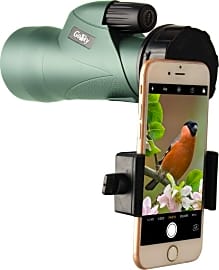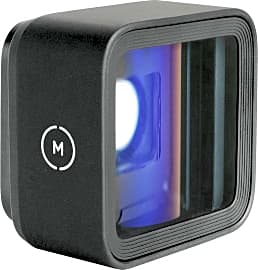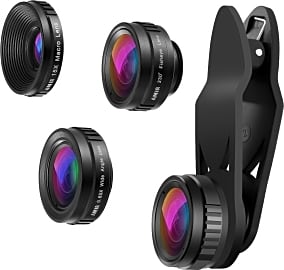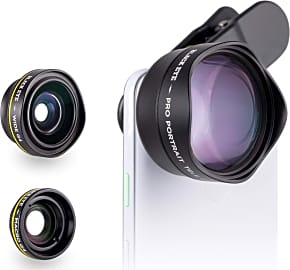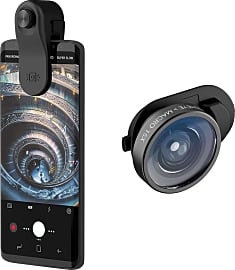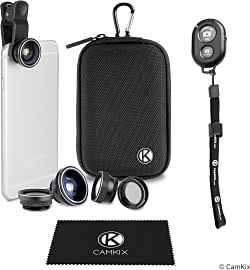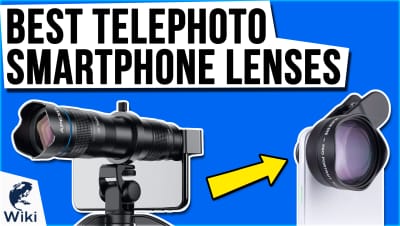The 10 Best Phone Camera Lenses

This wiki has been updated 40 times since it was first published in April of 2016. Today's smartphones boast impressive photographic capabilities, but if you want to take your snaps to the next level, check out these attachable camera lenses. While some are dedicated to specific functions, many of our selections come with multiple options to allow for visual experimentation. Just be sure to verify that whichever one you purchase is compatible with your device. When users buy our independently chosen editorial choices, we may earn commissions to help fund the Wiki.
Editor's Notes
November 05, 2020:
While there are a number of new items on the market competing with what was already on this list, most of them are somewhat low quality, with complaints of durability, image quality, and difficulties fitting the lens onto the camera. That said, the Ztylus Revolver M Series and the Black Eye G4 Kit rose above the others and earned a spot among our top ten. Keep in mind that not all of these will work for every phone, so be sure to verify that you are looking at one that fits your needs before finalizing the purchase.
You may notice that most of the options here are kits rather than single lenses. It's becoming increasingly popular to package these add-ons in a bundle as opposed to selling each one individually, so kits like the Amir 3-in-1 HD and Olloclip Essential Kit with their macro, wide, and fisheye lenses are now the norm rather than the exception. There is some variety in terms of which lenses are included, like the Black Eye G4 Kit substitutes the fisheye for its portrait lens, and others like the CamKix Universal Kit adds in a telephoto. If you want a complete package with loads to play around with, the Shuttermoon Pro has 11 different options, so a great way to start getting familiar with what each lens can do.
In terms of mounting options, most use clips that are fairly versatile in terms of the devices they can attach to, like the Xenvo Pro. Some of these, the Olloclip Essential Kit for instance, do have trouble attaching over phone cases, so you may need to remove it before you can start shooting, and all of them will leave vignetting in the corners of pictures if they aren't aligned properly. The Ztylus Revolver M Series offers a unique solution in its magnetic wheel with flip-out lenses that makes switching between focal lengths a snap and helps ensure lenses are properly aligned. The Gosky Skyhawk Monocular attaches using a clamp similar to those found on a lot of phone tripods to keep it in place, though some have had a hard time getting that properly aligned as well. Both the Moment Anamorphic and Moment Tele 58mm screw into place using a special phone case, which is the most reliable way to align the lens and hold it in place, but can be pricey. The Black Eye G4 Kit has that option as well, though it also functions with the included clip, so if you don't want to invest in an expensive case right now, it might be a good option.
December 03, 2019:
We added some of the more innovative lenses on the market with the Moment Tele 58mm and the Moment Anamorphic. This brand's quality is unmatched when it comes to durability, but also in providing professional quality images. The Anamorphic is particularly exciting, as it is this type lens that allows users to produce films that don't look like they were shot on a cell phone.
We replaced the Olloclip Core with the Olloclip Essential Kit, even though the Core's concept of enhancing the front and back camera simultaneously seemed convenient, the mounting clip required had a tendency not just to scratch, but break screens under the pressure. In addition, the Multi works with IOS and Android models.
Special Honors
Pro Edition For the dedicated iPhone enthusiast, Sandmarc designs its lenses for each new release to be compatible with the custom case that ships with the bundle. The Pro pack provides a case to go with each of the four different lenses, which many find to be overkill, especially since the cases tend to be slippery and not popular with most users. sandmarc.com
Award-winning Image Quality
That, alone, garnered the film a tremendous amount of attention, especially considering how good the footage looked.
One of the most impressive films in to come out of the 2016 Sundance Film Festival was shot almost entirely on an iPhone 5s. That, alone, garnered the film a tremendous amount of attention, especially considering how good the footage looked. When most people hear the claim, they picture the filmmakers holding forth their iPhones like tourists capturing a street performer in Time's Square, and the process couldn't be further from the truth.
The film, Tangerine, was, in fact, shot on an iPhone, but the iPhone in question was tricked out with a fancy app, a steadycam for fluidity in movement, and a rather expensive experimental 1.33 anamorphic lens adapter. The filmmaker, Sean Baker, even said of the lens, "To tell you the truth, I wouldn't have even made the movie without it."
If you really want to take your cell phone photography to the next level, to get cinematic quality video, gallery quality images, and astronomically beautiful pictures from space, among other things, you need to augment the lens at the back of your phone with more than just a pinch zoom.
The lenses on our list attach to your camera with the greatest of ease, simply snapping into their spots like a paper clip. Once in position, they'll bend the light heading into your phone's camera just before it gets there, giving you either a wider field of view (labelled wide-angle or fisheye) a tremendous amount of zoom (labelled as telephoto, or with a magnification multiplier), or occasionally the ability to get unbelievably close to your subject without it going out of focus (labelled macro).
The best part about these lenses is that competition to come up with the best, least expensive technology has driven the quality way up and the costs way down. Costly adapters from a few years ago now come as one in a set of three for a fraction of the price.
Zooming Toward A Choice
When you pinch to zoom with a cell phone camera, you're using something called digital zoom. You may remember seeing both optical zoom and digital zoom specs listed on the last digital camera you bought before our phones stole the entire market. Optical zoom refers to the actual movement of lens elements to bend and magnify the light before it hits your sensor. Digital zoom essentially just crops in on whatever resolution the sensor has already captured, reducing the quality of your images as you pinch.
Digital zoom essentially just crops in on whatever resolution the sensor has already captured, reducing the quality of your images as you pinch.
Any of the telephoto lenses on our list, including the telescopic and microscopic lenses, are optical enhancers, so the resolution of your image remains at its highest constant. The wide-angle lenses also maintain complete resolution, but there wasn't a threat to your image from going wider in the first place.
Choosing from among these sets will have everything to do with how you want to affect your image and what you want to shoot. I wouldn't recommend the microscope attachment for your next selfie, for example.
Most casual camera phone shooters would do well with any of the triptych clip-on lens adapters, the sets of three that include a fisheye, macro, and telephoto enhancement. These sets ought to satisfy the needs of anyone looking for a little enhancement without spending too much money.
The more specific the tasks you need tackled by some of these attachments, the more you're liable to spend on them, and the more limited their usage outside that task will be. The telescopic attachment is great for astronomical photography or for spying on your neighbors, but it's useless on anything that isn't a minimum distance from your camera. The microscopic attachment is probably the coolest thing on our list, and it would be a wonderful addition to any science classroom, but it wouldn't do to Instagram your brunch with it.
Old Glass, New Class
Lenses predate the invention of the camera by millennia. As long as there has been the written word, there have been stones carved and polished to allow readers with aging eyes to magnify and decipher smaller text. These lenses also proved useful in starting fires when they concentrated beams of sunlight onto a small pile of kindling.
As long as there has been the written word, there have been stones carved and polished to allow readers with aging eyes to magnify and decipher smaller text.
It was these single-element lenses that adorned the first cameras developed in the 19th century. Crude as they were, the lenses produced a lot of artifacts, as well as a significant amount of field distortion. By the late 1800s, however, photographers and lens manufacturers had begun to combine lens elements to cut down on distortion and to create clearer images that allowed more light to pass onto the exposure surface.
Fast forward another century, and the cell phone age is in full swing. Right there alongside it, the digital photography revolution roils on, and before long the two worlds collide, as several phone manufacturers integrate simple cameras into their cell phone bodies. It starts out seeming like a novelty, but by the time the first iPhones hit shelves in 2007, phone cameras begin to look like serious contenders among casual photographers.
The camera industry responded by trying to make everything about their systems smaller, going so far as to do away with the reflex mirror in their most expensive and prestigious models, with Canon and Nikon notably holding out against the tide. They'll come around, eventually, but by then everybody will have a good phone and a better set of lenses like these for it.



